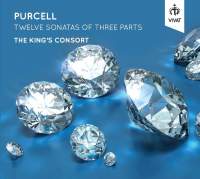Texte paru dans: / Appeared in: |
|
|
Outil de traduction ~ (Très approximatif) |
|
|
Reviewer: Bertil
van Boer There can be no doubt that Henry Purcell was in the middle of a creative spurt when in 1683 he announced the publication by subscription of a set of 12 Trio Sonatas in the London Gazette. The works were probably inspired by the publication two years earlier of Archangelo Corelli’s op. 1 Trio Sonatas, though the genre itself was certainly one that was emerging elsewhere in Europe as the chamber music par excellence. For Purcell, this may even have been conceived as a paean to earlier English instrumental works of his predecessors, as well as pointing the way towards the future in which the country would participate in the general musical trends of the continent. This is sort of the inference from his own preface to the set. In any case, the composer was apologetic when he stated that the set had been delayed due to the need to engrave a separate continuo part, something that Corelli had done in his sonatas as an imitative idea to contrast the continuo instruments alongside the two violins. To be precise, these 12 works are gems (with an appropriate metaphoric depiction on the cover with various polished diamonds). Each one seems to have a different character, even if the overall formats are similar. The First Sonata in G Minor (Z 790) seems like it ought to be more French in style, and yet the solemn Corellian opening erupts into a rather Quixotic fugue before falling back into a lament. The fugue rises again and then falls back finally into a flowing dance in the major key. Along the way can be found some interesting and close dissonances that quickly disappear, and the work dies away like a ghostly shade. The C-Major Sonata (Z 795) has a rather clever development in which the bass line and both violins use the same theme at different augmentations in the beginning, creating both a rich texture and slow moving counterpoint that flows. The continuation has one entry beginning with the first violin that keeps repeating with bits of the spread out triads and scales until uniting briefly in parallel thirds, occasionally veering out of harmonic control with some fluid chromaticism. A light and fluffy minuet follows before the entire sonata concludes with a flurry of twisting imitative violin lines before petering out. In the F-Minor Sonata (Z 800), Purcell was confronted with a difficult key for composers of that period. He chooses at the beginning to meander chromatically in a smooth flow, with suspensions and some close harmonies lending it a solemn and pensive character. There is an occasional hint of fauxbourdon (parallel fourths) in the faster second section with its rather dexterous modal counterpoint, but in the third section, the pungent harmonies that stray far from the home key unfold like flower petals, many far more adventurous than anything Corelli might have written. The work ends with a series of cascading sequential lines like small torrents running over themselves. All of the other works display the same sort of intricacies as these brief examples, making this an important set of original sonatas. This is of course not the first time that this set has been recorded. In 2011, Linn Records issued a SACD with the Retrospect Trio, which is a fine set. The close sonorities of the King’s Consort members, however, are to be preferred, given that they seem to move through the variable technical aspects as one. The violin playing by Cecilia Bernardini and Huw Daniel are evenly matched, and the continuo group led by Robert King provides a solid and cohesive foundation. Together, they bring out Purcell’s unique take on the newly developed trio sonata without succumbing to interpretational conventionality. The focus is on allowing the features to emerge from the music itself, and to my mind this is the appropriate focus. Highly recommended. | |
|
|
|
|
Cliquez l'un ou l'autre
bouton pour découvrir bien d'autres critiques de CD |
|




